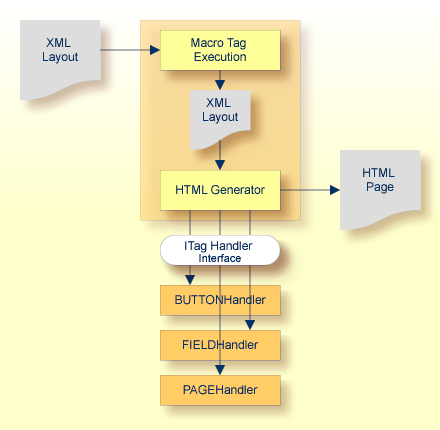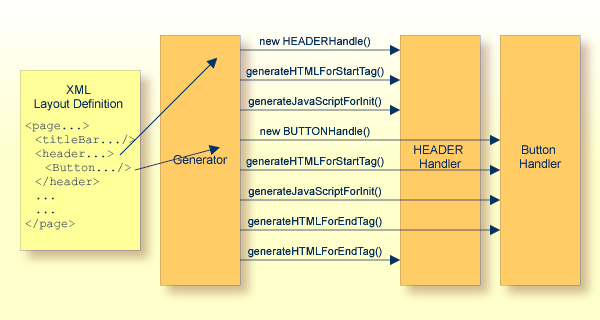This document covers the following topics:
The page generation is the process of transferring an XML layout definition into an HTML/JavaScript page. It is automatically executed inside the Layout Painter when previewing a layout. It can also be called from outside.

A generator program
(com.softwareag.cis.gui.generate.HTMLGenerator) is
receiving a string which contains the XML layout definition. The generator
program parses this string with a SAX parser and as a consequence processes the
string tag by tag.
The generation of HTML pages is done in two steps:
Macro Execution
First, each tag of the XML layout is checked if it is a so-called
"macro tag". A macro tag is a tag which does not produce
HTML output itself but which
itself produces XML tags. Imagine a control rendering an address input: this
control is using existing controls in order to create some defined output area
representing an address. The HTML
is not produced by the address control directly - the address control
internally creates other controls (such as fields or buttons) which themselves
produce corresponding HTML
code.
The execution of macro tags is recursively done until no macro tag is contained in the XML layout anymore; that is, macro tags themselves can internally use macro tags.
HTML Generation
After having executed the macros, the rendering of HTML
is started: for each tag, the renderer creates one
object of a tag handler class, that it finds via library definitions and naming
conventions.
Each tag handler is called via a defined interface
(com.softwareag.cis.gui.generate.ITagHandler) and
is invited to take part in the generation process. It
gets all the tag data including the attributes from the layout definition and
it gets the HTML string "on the right" and is allowed to append
own information into this HTML string.
A tag handler instance is called at three different points of time by the generator:
when the tag is starting (for example, the generator finds "<page…>"),
when the tag is closing (for example, the generator finds "</page>"),
when the generator creates a defined JavaScript method which is called at runtime in the browser when the page is loaded.
It is now the task of the tag handler to create HTML/JavaScript statements at the right point of time.
The following topics are covered below:
The interface
com.softwareag.cis.gui.generate.IMacroTagHandler
contains two methods which represent the different points of time when the
generator calls the tag handler during the macro execution phase.
package com.softwareag.cis.gui.generate;
import org.xml.sax.AttributeList;
import com.softwareag.cis.gui.protocol.ProtocolItem;
public interface IMacroTagHandler
{
public void generateXMLForStartTag(String tagName,
AttributeList attrlist,
StringBuffer sb,
ProtocolItem pi);
public void generateXMlForEndTag(String tagName,
StringBuffer sb);
}
Detailed information about the methods can be found inside the Javadoc documentation which is part of your Application Designer installation. See also Developing Java Extensions in the Ajax Developer documentation.
The interface
com.softwareag.cis.gui.generate-ITagHandler contains
three methods that represent the different points of time when the generator
calls a tag handler during the HTML generation phase.
package com.softwareag.cis.gui.generate;
import org.xml.sax.AttributeList;
import com.softwareag.cis.gui.protocol.*;
public interface ITagHandler
{
public void generateHTMLForStartTag(int id,
String tagName,
AttributeList attrlist,
ITagHandler[] handlersAbove,
StringBuffer sb,
ProtocolItem protocolItem);
public void generateHTMLForEndTag(String tagName,
StringBuffer sb);
public void generateJavaScriptForInit(int id,
String tagName,
StringBuffer sb);
}
Detailed information about the methods can be found inside the Javadoc documentation which is part of your Application Designer installation. See also Developing Java Extensions in the Ajax Developer documentation.
A tag is processed by the generator in a certain way that is now described for the HTML generation phase. (The macro execution phase is processed in a similar way.)
The generator finds the tag, reads its properties and assigns an ID. The ID is unique inside one page.
The generator creates a new instance of the tag handler which is responsible for processing the tag.
The generator calls the
generateHTMLForStartTag method. It passes the list of properties,
the string buffer which represents the HTML/JavaScript string and a protocol item in which the tag handler can store
further information.
The
generator calls the generateJavaScriptForInit method.
It passes as main parameter a string representing the method body of the
initialisation method. You can append JavaScript
statements to this string.
(If the generator finds tags below the current tag, these tags are processed in the same way now.)
The generator finds the end tag and calls the
generateHTMLForEndTag method.
The following image illustrates the call sequence for tag handlers:

Be aware of the following:
There is one instance of a corresponding tag handler per tag. If
there are three button definitions inside a layout definition, then during
generation there are three instances of the
BUTTONHandler class.
There is one instance of a protocol item which is passed as parameter per tag. Each tag has its own protocol item. All the protocol items are collected at generation point of time to form one generation protocol.
There are certain interfaces which extend the framework for specific situations:
com.softwareag.cis.gui.generate.IMacroHandlerWithSubTags
- this is an extension of IMacroHandler and provides the
possibility to also receive subtags of a tag.
com.softwareag.cis.gui.generate.ITagWithSubTagsHandler -
this is an extension of the ITagHandler interface and
provides the possibility to also receive the subtags of a tag.
com.softwareag.cis.gui.generate.IRepeatCountProvider and
com.softwareag.cis.gui.generate.IRepeatBehaviour - these
interfaces are responsible for controlling a special management for the REPEAT
processing, which you use, for example, inside grids (ROWTABLEAREA2).
You do not need to know anything about these extensions to create your first controls. Documentation is provided inside the Javadoc documentation. See also Developing Java Extensions in the Ajax Developer documentation.
The library concept is responsible for defining the way how the generator finds a tag handler class for a certain tag. There are two situations:
The generator finds a tag without a ":"
character. This indicates that this is a native
Application Designer tag - the according tag handler is found inside the
package com.softwareag.cis.gui.generate, the class name
is created by converting the tag name to upper case and appending
"Handler".
For example, if the generator finds the tag
"header", it tries to use a tag handler class
com.softwareag.cis.gui.generate.HEADERHandler.
The generator finds a tag with a ":"
character, for example, demo:address. This indicates that an
external control library is used. The generator looks
into a certain configuration file
(<installdir>/config/controllibraries.xml) and finds
out the package name which deals with the "demo:"
library. After having found the package name, the class name
is built in the same way as with standard Application Designer controls.
For example, if the generator finds the tag demo:address
and in the configuration file the demo prefix is assigned to the package
com.softwareag.cis.demolibrary, then the full class name
of the tag handler is
com.softwareag.cis.demolibrary.ADDRESSHandler.
What happens if the generator does not find a valid class for a certain tag? In this case, it just copies the tag of the layout definition inside the generated HTML/JavaScript string. Via this mechanism, it is possible to define, for example, HTML tags inside the layout definition which are just copied into the HTML/JavaScript generation result.
A control library is a Java library containing
ItagHandler/IMacroTagHandler
implementations. The corresponding
.jar file has to be part of the Application Designer application
libraries in order to be found inside the Layout Painter and Layout Manager; i.e. it
can be copied, for example, into the
<webappdir>/<projectdir>/appclasses/lib
directory.
The central control file for configuring control libraries in your installation is the file <webappdir>/cis/config/controllibraries.xml. An example of the file looks as follows:
<controllibraries> <library package="com.softwareag.cis.demolibrary" prefix="demo"> </library> </controllibraries>
Each library is listed with its tag prefix and with the package name in which the generator looks for tag handler classes.
The normal binding concept between a page and a corresponding class is:
Controls refer to properties and methods.
Properties and methods are
directly implemented as
set/get methods or as
straight methods inside the adapter class.
As you might already have read in the part Binding between Page and Adapter of the Special Development Topics, the binding is much more flexible. You can define hierarchical access paths for both methods and properties.
For example, you can define a FIELD control which binds to the property
address.street. As a consequence, the adapter is
first asked for an object via a getAddress() method.
Then the result of this method is asked for
getStreet(). The same is true for methods: in a BUTTON
control, you can define the method address.clear - as
a consequence, the adapter again is first asked for
getAddress(), then the method
clear() is called in the result object.
Why is this important with controls? Well, it is especially important for composing controls: you might want complex controls, e.g. an address control which internally is composed out of 10 FIELD controls, to be represented on the server side by a corresponding server class which matches the property and method requirements of the control. Even more: if you add an additional FIELD control to the address control, then you might not want to update all adapter classes, but just want to update the corresponding server class.

In analogy to the "Adapter", which is the representation of a whole page, the server side classes, which deal with certain controls, are called "Control Adapter" classes.
This all sounds a bit abstract - wait for the control adapter code example. Then you will see how powerful and simple this binding concept is.
Once having created new controls, you want to use them inside the Layout Painter. The Layout Painter is configured by a set of XML files, all of them located inside <webappdir>/cis/config/:
editor.xml
editor_*.xml
Have a look at the editor.xml file: all controls that come with Application Designer are listed inside this file. Each control defines the attributes that can be maintained and defines how it fits into other controls. Data type definitions to provide value help for the attributes is defined as well inside this file.
In short: editor.xml controls the way in which controls are presented inside the Layout Painter.
When creating new controls, you want to integrate your controls into the Layout Painter, that is, you want to register them inside editor.xml as well. Instead of letting you directly manipulate editor.xml, there is an extension concept - in order to keep your definitions untouched by release upgrades. There are some editor_*.xml files, each of the files containing the definitions of editor.xml for a certain control library.
Have a look at the editor_demo.xml file:
<!-- DEMO:ADDRESSROWAREA2 -->
<tag name="demo:addressrowarea2">
<attribute name="addressprop" mandatory="true"/>
<protocolitem>
</protocolitem>
</tag>
<tagsubnodeextension control="pagebody" newsubnode="demo:addressrowarea2"/>
In this example, a new control demo:addressrowarea2 is
defined:
It provides one property
addressprop.
It can be placed into the existing Application Designer control
pagebody.
Or have a look at the following section:
<!-- DEMO:ADDRESSROWAREA3 -->
<tag name="demo:addressrowarea3">
<attribute name="addressprop" mandatory="true"/>
<taginstance>
<rowarea name="Address">
<itr>
<label name="First Name" width="100">
</label>
<field valueprop="$addressprop$.firstName" width="150">
</field>
</itr>
<itr>
<label name="Last Name" width="100">
</label>
<field valueprop="$addressprop$.lastName" width="150">
</field>
</itr>
<vdist height="10">
</vdist>
<itr>
<label name="Street" width="100">
</label>
<field valueprop="$addressprop$.street" width="300">
</field>
</itr>
<itr>
<label name="Town" width="100">
</label>
<field valueprop="$addressprop$.zipCode" width="50">
</field>
<hdist width="5">
</hdist>
<field valueprop="$addressprop$.town" width="245">
</field>
</itr>
<vdist height="10">
</vdist>
<itr>
<hdist width="100">
</hdist>
<button name="Clear" method="$addressprop$.clearAddress">
</button>
</itr>
</rowarea>
</taginstance>
<protocolitem>
<addproperty name="$addressprop$" datatype="ADDRESSInfo" useincodegenerator="true"/>
</protocolitem>
</tag>
<tagsubnodeextension control="pagebody" newsubnode="demo:addressrowarea3"/>
The control demo:addressarea3 has the following
features:
It provides one property
addressprop.
It contains the macro XML (between <taginstance>
and </taginstance>) for building the control out of existing
controls.
It binds to an address property of type
ADDRESSInfo (between
<protocolitem> and </protocolitem>).
It can be positioned below the pagebody control.
The editor_*.xml files should not be maintained by yourself directly. Instead, use the Control Editor to define the file in a comfortable way.
When defining new controls, there are the following resources:
<webapp>/cis/config/controllibraries.xml - to define control library prefixes and their binding to a certain Java package holding control implementations.
<webapp>/cis/config/editor_*.xml - to define the controls and how they fit into existing controls.
IMacroTagHandler - implementations that
transfer XML control definitions into other XML control definitions.
ITagHandler - implementations that transfer
XML control definitions into HTML/JavaScript.
The next section contains examples for building macro controls and new controls.